2023 LinkedIn data on OECD.AI: Definitions for AI occupations are more specific, women in more AI jobs as career transitions to AI grow

Since our partnership with LinkedIn began, we’ve gained unprecedented insights into the evolving AI landscape in the workplace. 2023 data from LinkedIn, published today on the OECD.AI Policy Observatory, show trends in AI skills migration, penetration, talent concentration, hiring, career transitions, etc.
As the use of AI increases everywhere, its influence reshapes the labour market for workers and employers alike. LinkedIn’s 2024 Work Trend Index Annual Report shows a rising demand from both sides to leverage AI in the workplace. A staggering 75% of global knowledge workers now incorporate AI into their daily routines. Employees see AI as a tool that helps them save time, focus on high-priority tasks, boost creativity, and enjoy their work.
On the other hand, employers increasingly seek talent with AI expertise, and AI-related hiring has surged by 323% over the past eight years. Furthermore, there has been a notable increase in job applications for AI-related roles: LinkedIn posts that mention AI have seen 17% greater application growth in the last two years compared to job posts that don’t mention AI.
The integration of AI into the workforce does not just transform job roles. It also creates a new landscape of skills and opportunities. With the rise of generative AI, new diverse AI competencies, including non-technical abilities like using tools such as ChatGPT and Copilot, are becoming highly sought after in today’s job market.

LinkedIn adds nuance to how it classifies AI talent
As AI evolves, so must AI occupations and associated skills. AI’s growing complexity and specialisation demand clearer concepts for what constitutes AI talent. Previously, AI skills were grouped into a single category, encompassing around 38,000 distinct skills. However, LinkedIn recognised the need for a more nuanced classification and split AI skills into AI Engineering and AI Literacy. These categories now cover over 41,000 skills and clarify the diverse expertise required in AI occupations.
AI Engineering includes technical skills like machine learning, natural language processing, and deep learning, all crucial for developing and implementing AI systems. On the other hand, AI Literacy includes skills related to using AI tools and platforms, such as prompt engineering and familiarity with GPT-3/4 and Google Bard. This new classification reflects the growing role of generative AI in the workplace and the increasing demand for diverse AI-related skills in the job market.
A LinkedIn member is considered AI talent if working in an AI occupation. This ensures a more accurate representation of AI talent and helps identify truly skilled individuals, reflecting the growing importance of a solid AI skill set in today’s job market.
Women have more AI talent and occupy more AI roles in all sectors than they did in 2022, except finance
New LinkedIn data provides valuable insights into gender representation among AI talent. Globally, the proportion of women in AI roles is growing, although the pace remains slow. In 2023, approximately 0.4% of male LinkedIn members and 0.2% of female LinkedIn members had AI skills, with the year-over-year growth rate in AI talent concentration being higher for women than for men (Figure 1).
Figure 1. The proportion of women with AI engineering skills is growing faster than men, although the pace remains slow
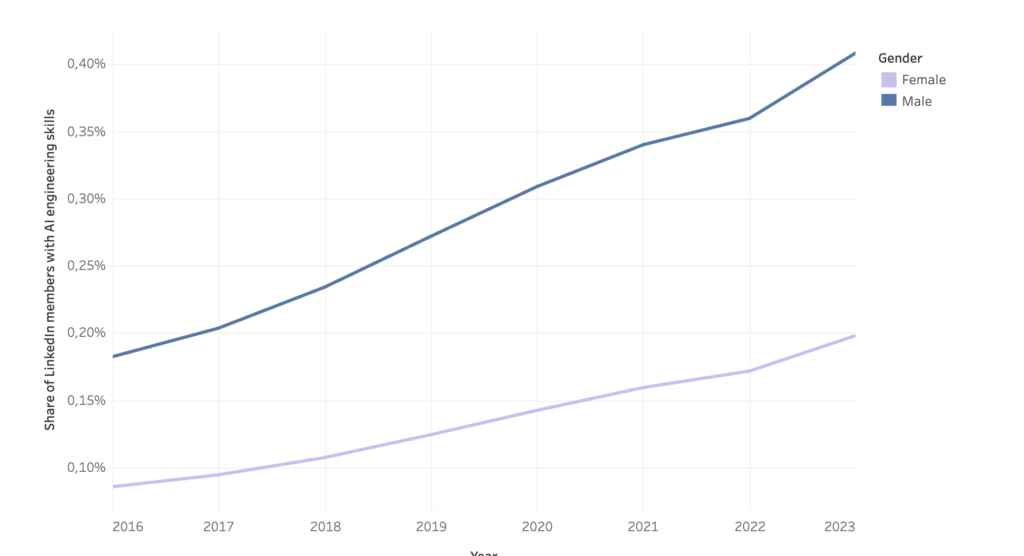
Source: LinkedIn Economic Graph Research Institute
Visit chart on oecd.ai
In 2023, women comprised an average of 26.8% of AI engineering skills, up from 24.9% in 2016 (Figure 2). Notably, 18 countries and territories exceed this global average, with Singapore leading the way, where nearly 35% of AI talent are women. Between 2022 and 2023, 33 out of 43 countries observed an increase in the proportion of female AI engineering talent.
Figure 2 On average, about 27% of AI talents with AI engineering skills are women in 2023
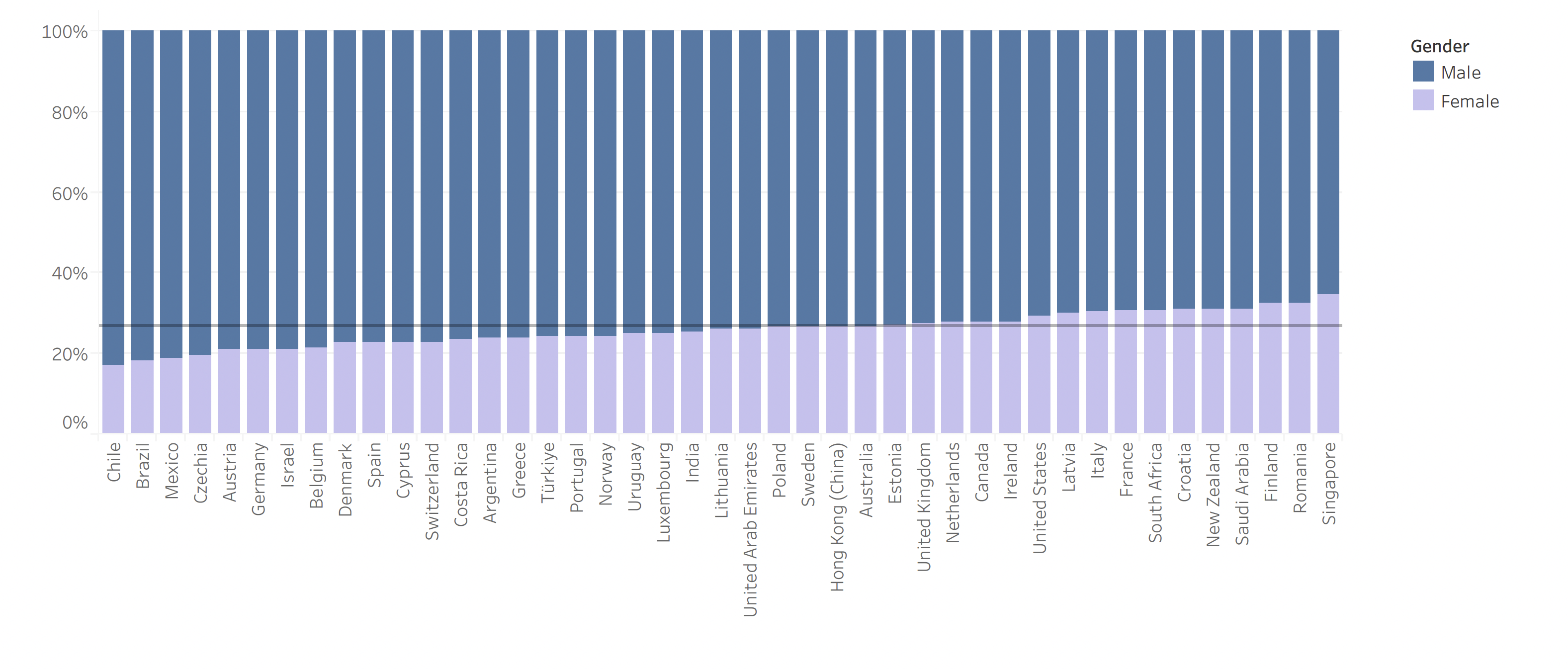
Source: LinkedIn Economic Graph Research Institute
Visit chart on oecd.ai
The share of female AI engineering talent increased from 2022 to 2023 at the industry level in sectors such as technology, information and media, manufacturing, professional services, and education. Women represent between 23% and 30% of AI talent across these industries (Figure 3).
The education industry stands out with the highest concentration of female AI talent, possibly due to a higher proportion of women working in this sector. In 2023, women comprised 29% of AI engineering talent in education, an increase from 27% in 2016. Conversely, the manufacturing and technology sectors have a lower-than-average concentration of female AI engineering talent. Nonetheless, these sectors and professional services also saw a 2 to 3 percentage point increase in the share of female AI engineering talent over the same period. Meanwhile, the financial services sector experienced a decline, with the proportion of women in AI roles dropping from 31% to 28%.
Figure 3 Across select industries, women made up between 1 fifth and 1 third of AI talents with AI engineering skills in 2023
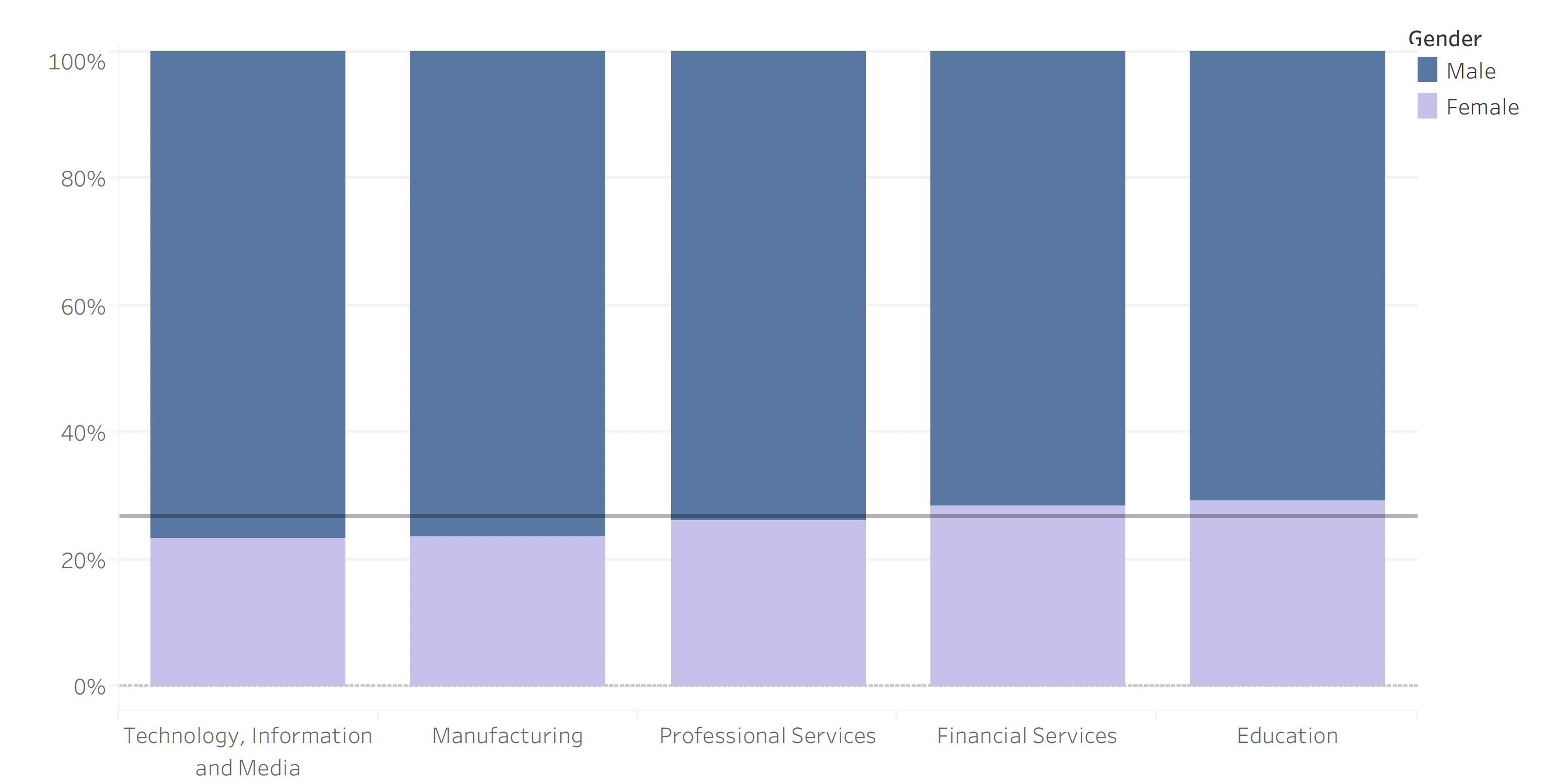
Source: LinkedIn Economic Graph Research Institute
Visit chart on oecd.ai
More people are occupying AI-related roles for the first time, reflecting higher demand across sectors
The OECD.AI Observatory features charts that provide insights about transitions into AI jobs across various countries. These charts illustrate the percentage of professionals moving into AI roles, whether from AI or non-AI-related occupations, over five years, tracking individuals as they transition from one occupation to a new role they have never held. Some AI occupations are data scientists, machine learning, algorithm, and research engineers, while non-AI occupations include software engineers, data analysts, and research assistants.
Data from 19 countries show that most transitions into AI roles come from non-AI occupations, underscoring the growing interest in AI careers (Figure 4). For instance, 56% of LinkedIn users in Singapore who transitioned into AI roles came from non-AI backgrounds. 17% of all talents who transitioned to an AI occupation came from non-AI software engineering roles (Figure 5). Additionally, the remaining 44% of transitions into AI roles in Singapore were from within the AI field, and approximately one-fifth of all talents transitioning into AI occupations previously worked as data scientists, an AI occupation.
Figure 4 Talents transitioning into AI occupations come from both non-AI and AI backgrounds
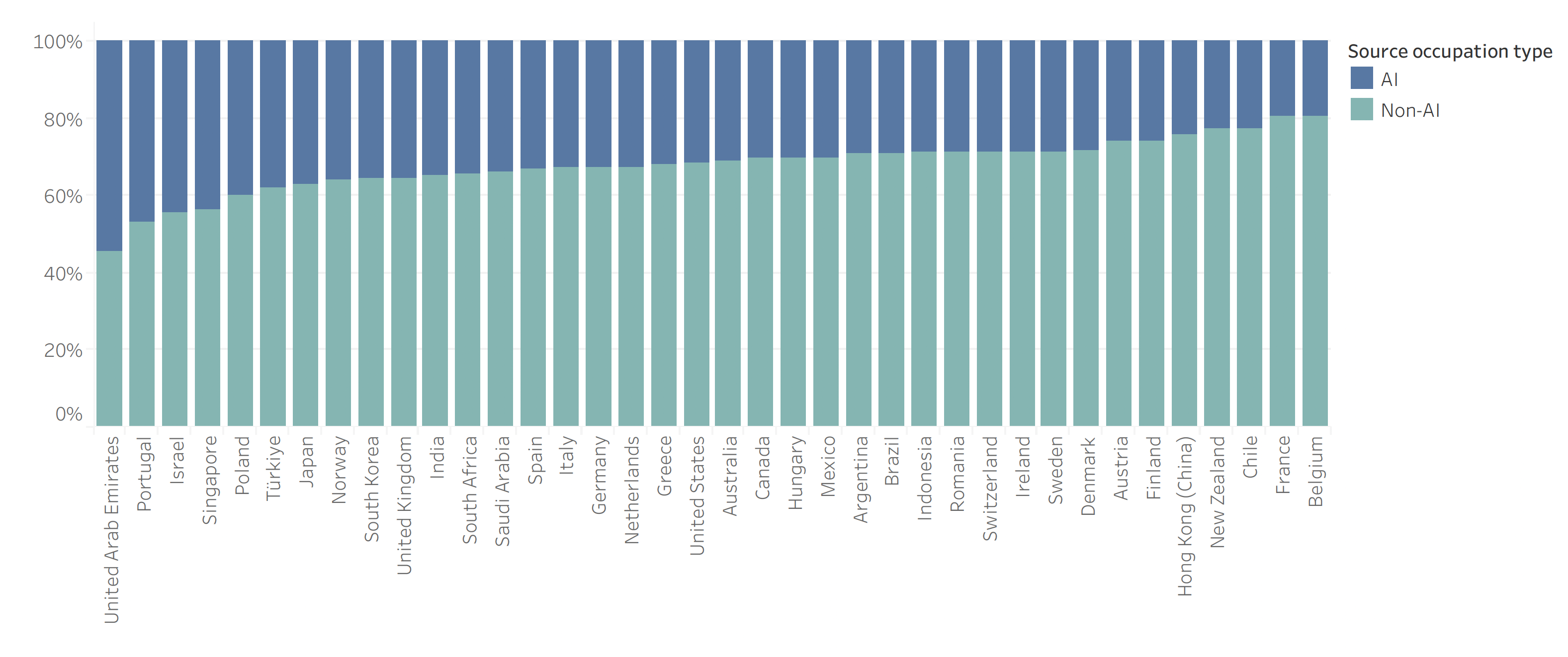
Source: LinkedIn Economic Graph Research Institute
Visit chart on oecd.ai
Figure 5 Career transitions to AI occupations in Singapore, 2023
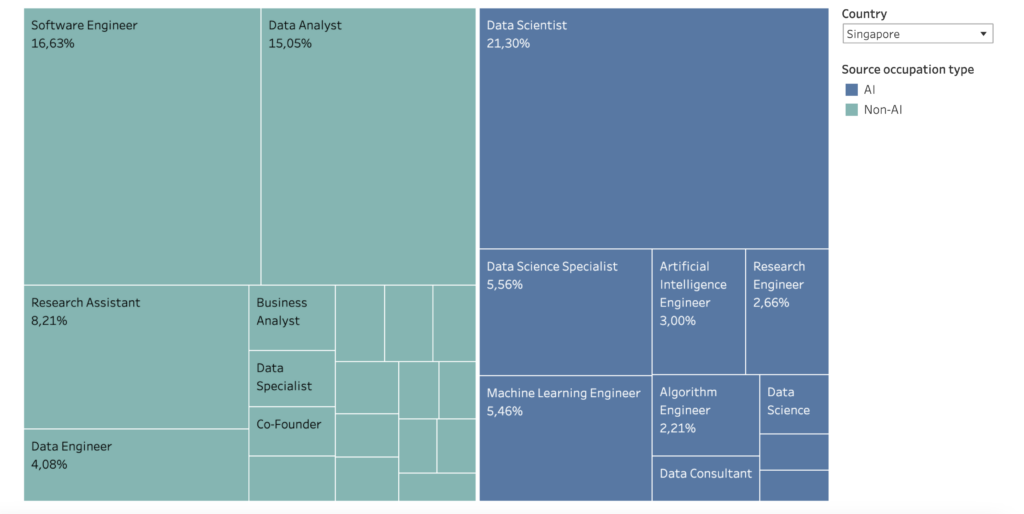
Source of data: LinkedIn Economic Graph.
Visit chart online
Policymakers’ work will benefit from a clearer perspective on the supply and demand of AI talent
The latest 2023 LinkedIn data from OECD.AI offer a look into the evolving landscape of AI occupations and their demographic dynamics.
The new categories for AI occupations provide a more detailed framework for identifying AI talent, which can help pinpoint skills gaps and align workforce development with industry demands. As AI technology advances rapidly, these categorisations should keep pace to reflect the evolving nature of AI-related jobs and skills accurately. LinkedIn is keeping up with the trend of distinguishing between AI engineering and AI literacy skills. Still, despite their significant knowledge and contributions to the field, some people with AI talents, such as policymakers and researchers who work extensively on AI, might be classified as something other than AI talent under the current definition. As the definition of AI talent expands, it should include all emerging types of AI skills.
As mentioned above, the data also reveals a gradual increase in the representation of women in AI roles, particularly within the education sector. This trend represents progress towards gender parity but also signals a persistent gender gap and disparities across countries and sectors. It calls for initiatives encouraging more women to pursue and advance in AI careers, especially in fields where their presence is still underrepresented.
Furthermore, the growing trend of career transitions into AI points to the need for comprehensive reskilling and upskilling programmes. As professionals from various backgrounds seek to enter the AI field, creating accessible training opportunities and clear pathways to AI careers will be essential for harnessing this talent pool effectively.
These insights underscore how crucial it is to monitor and update our understanding of AI talent and skills as the field evolves. Both workers and employers need these insights to prepare themselves best to navigate the future of AI.
LinkedIn recognises that gender identity isn’t binary and that some LinkedIn members identify beyond the traditional gender constructs of “man” and “woman.” If not explicitly self-identified, the gender of members included in this analysis has been inferred either by the pronouns used on their LinkedIn profiles or by the basis of first name. Members whose gender could not be inferred as either men or women were excluded from this analysis.
Economists and Data Scientists from LinkedIn’s Economic Graph Research Institute have devised and applied thresholds for public data sharing. These thresholds ensure that the number of members per country, number of members reporting certain types of skills, and/or share of members for whom gender data can be imputed are substantial enough to support meaningful inferences from the data.
Private-sector, user-generated data should not be assumed to represent the entire labour market. Still, it can offer clarity on labour market shifts and trends, particularly in tech-enabled industries. The World Bank explored the representativeness of LinkedIn’s data.




































